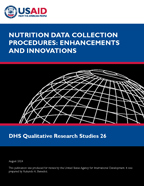There is no printed copy available to order.
Abstract:
The Demographic and Health Surveys (DHS)
Program is a leading source of national and
subnational
nutrition data. Countries use nutrition
indicators measured through DHS surveys to
develop policies,
evaluate programs, and reach nutrition
targets. Several recommendations to improve
the collection of data
on anthropometry, hemoglobin, and infant and
young child feeding practices have been
incorporated into
DHS-8. Five activities consisting of
observations, interviews, and focus groups
discussions with informants
(that is, implementing agency staff,
biomarker technicians, team supervisors, and
DHS interviewers) were
conducted to document the implementation of
nutrition data collection in DHS-8 surveys
and to explore
new methodologies. Results of activity 1
suggest that the severe acute malnutrition
referral process should
continue to be documented and that referral
monitoring could be enhanced. Activity 2,
which examined the
capture of data from food and drink questions
in the Woman’s Questionnaire, identified a
need for more
awareness of the “foods and drinks” menu
button in the computer-assisted personal
interviewing system.
Activity 3 resulted in a recommendation to
use high flow, contact-activated Becton
Dickinson lancets
(instead of Unistik lancets) to draw
capillary blood for biomarker collection in
all populations. For
measuring children’s height/length,
activities 4 and 5 tested SECA equipment as
an alternative to
ShorrBoards and evaluated the feasibility of
using multiple measurements instead of single
measurements,
respectively. Results suggest continued use
of ShorrBoards, but exploration and use of
alternative
equipment if ShorrBoard quality issues
persist, and the need for more exploration of
multiple measurement
techniques. These findings and
recommendations will be used to strengthen
DHS survey processes and
direct future research in a variety of
country contexts.
 Nutrition Data Collection Procedures: Enhancements and Innovations (PDF, 1630K)
Nutrition Data Collection Procedures: Enhancements and Innovations (PDF, 1630K)
